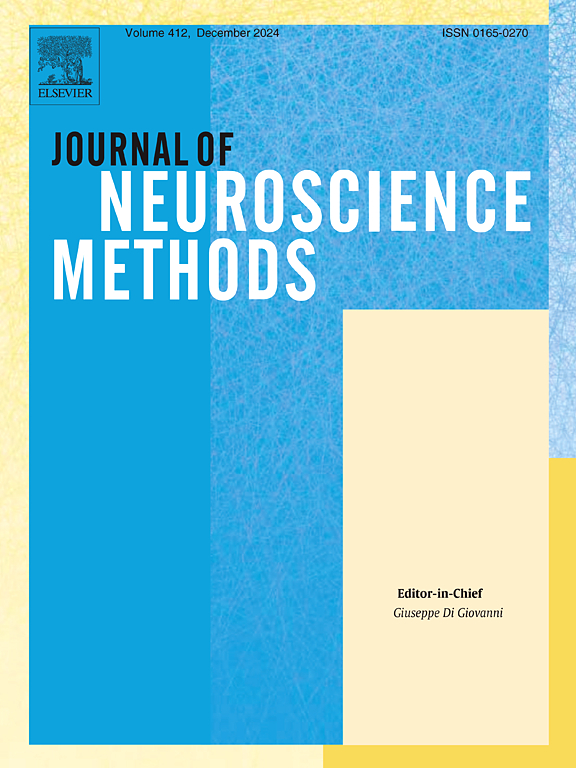并行TMS-fMRI进行层间刺激。
IF 2.3
4区 医学
Q2 BIOCHEMICAL RESEARCH METHODS
引用次数: 0
摘要
背景:经颅磁刺激(TMS)与功能性磁共振成像(fMRI)可以提供大脑活动和行为之间因果关系的见解。然而,TMS脉冲可能会在fMRI数据中引起伪影,但如果它们在MRI切片获取之间的短间隙中呈现(片间TMS-fMRI),则可以避免这些伪影。新方法:我们收集了TMS-fMRI数据,以提供1)所需差距的指导;2)更高层次的框架和代码,供研究人员测试他们自己的协议。我们量化了在切片激励前后高达100ms的TMS脉冲的fMRI数据(球形幻影)中的信号差和时间信噪比。我们在西门子3T Prismafit扫描仪上提供了每个体积最多3个脉冲,切片间隙为37.5ms/100ms(切片时间为62.5ms),两个7通道tms专用表面线圈和一个多波段序列(因子=2)。我们用人类参与者重复了一组参数。结果:我们观察到,当脉冲从切片激发至少施加-20ms/+50ms时,数据污染最小,并证实该方法可用于10Hz TMS。与现有方法的比较:与其他避免TMS脉冲相关伪影的策略相比,夹层在TMS脉冲的时间、MRI读出和任何刺激呈现方面具有更大的灵活性。结论:大于10Hz的刺激频率需要更短的间隙或更短的切片采集时间。此外,刺激器强度、切片方向和TMS脉冲的数量会影响数据质量,这是研究人员在建立自己的协议时需要考虑的重要因素。本文章由计算机程序翻译,如有差异,请以英文原文为准。
Conducting interslice stimulation for concurrent TMS-fMRI
Background
Transcranial magnetic stimulation (TMS) concurrent with functional magnetic resonance imaging (fMRI) can provide insights into the causal relationships between brain activity and behaviour. TMS pulses can cause artifacts in fMRI data, but these can be avoided if they are presented in short gaps between MRI slice acquisitions (interslice TMS-fMRI).
New method
We collected TMS-fMRI data to provide 1) guidance on the gap required and 2) a higher-level framework and code for researchers to test their own protocols. We quantified signal dropout and temporal signal-to-noise ratio in fMRI data (spherical phantom) for TMS pulses presented from up to 100 ms before and after slice excitation. We delivered up to 3 pulses per volume with interslice gaps of 37.5 ms/100 ms (slice time 62.5 ms), two 7-channel TMS-dedicated surface coils, and a multiband sequence (factor=2), on a Siemens 3 T Prismafit scanner. We repeated a subset of parameters with a human participant.
Results
We observed minimal data contamination when pulses were applied at least −20 ms/+ 50ms from slice excitation, and confirmed this approach can be used with 10 Hz TMS.
Comparison with existing methods
Compared to other strategies that avoid TMS pulse-related artifacts, interslice allows for greater flexibility in terms of timing of the TMS pulse, MRI read out and any stimulus presentation.
Conclusion
A 10 Hz TMS interslice protocol is possible with minimal data contimination. A stimulation frequency faster than 10 Hz would require a shorter gap or shorter slice acquisition times. Further, stimulator intensity, slice orientation, and the number of TMS pulses affected data quality and are important considerations for researchers when setting up their own protocol.
求助全文
通过发布文献求助,成功后即可免费获取论文全文。
去求助
来源期刊

Journal of Neuroscience Methods
医学-神经科学
CiteScore
7.10
自引率
3.30%
发文量
226
审稿时长
52 days
期刊介绍:
The Journal of Neuroscience Methods publishes papers that describe new methods that are specifically for neuroscience research conducted in invertebrates, vertebrates or in man. Major methodological improvements or important refinements of established neuroscience methods are also considered for publication. The Journal''s Scope includes all aspects of contemporary neuroscience research, including anatomical, behavioural, biochemical, cellular, computational, molecular, invasive and non-invasive imaging, optogenetic, and physiological research investigations.
 求助内容:
求助内容: 应助结果提醒方式:
应助结果提醒方式:


